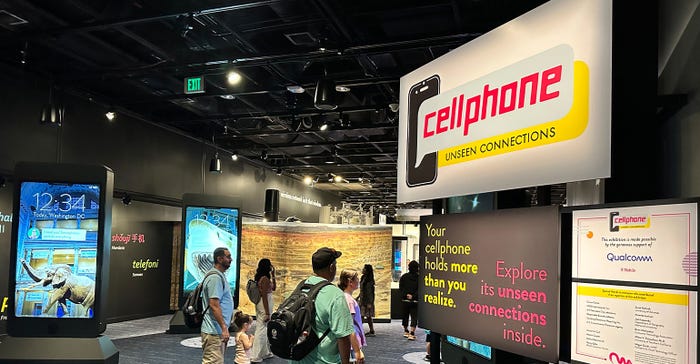Natural History Museum Exhibit Puts Cellphone Recycling Education on Display
The Smithsonian’s National Museum of Natural History is packed full of interesting exhibits detailing subjects like evolution and geology. Now cellphones, their endless connectivity, and their environmental impact are on full display.

The Smithsonian’s National Museum of Natural History is packed full of interesting exhibits detailing subjects like evolution and geology. Now cellphones, their endless connectivity, and their environmental impact are on full display.
Last week, the Smithsonian’s National Museum of Natural History opened their latest exhibit, Cellphones: Unseen Connections. The exhibit takes on the role of educating museumgoers on the history of our handheld devices, the materials that go into cellphones, and what the final stages of our phone’s lives have on our environment.
Cellphones are the fastest growing technology in human existence. With new innovations being developed constantly, consumers are upgrading and disposing of their devices at an alarming rate. Most people don’t know what to do with their phones once they’ve upgraded to a new one or their old phone is broken. But fortunately, the Museum’s Cellphone exhibit helps interested parties discover ways of properly disposing of their devices and the consequences of throwing them in the trash.
A big wall of the exhibit is dedicated to proper cellphone disposal and “The How of Recycling.” The purpose of this area is to show attendees what happens to their phones once they’re put into our recycling facilities, with details on the effects of proper dismantling, shredding, and smelting.
Of course, these methods come with their own issues and hazards as many cellphone makers create phones to discourage dismantling and encourage consumers to buy new devices, rather than repair them to extend the life of the device, promoting a circular economy. The exhibit notes that in 2021, the Fairphone 3, Teracube 2e, Google Pixel 5, and Moto E6 were praised for their use of sustainable and recycled materials and their repairability.
Continuing to the left is more education on the recycling or “urban mining” that is done with cellphones and other electronic devices. A display case breaks down, piece by piece, what parts of cellphones can be recycled, such as the palladium, glass that is intact, cobalt from the batteries, and sometimes the plastics.
“There is 10 times more gold, silver, platinum, and palladium in 1 ton of our electronics than in 1 ton of ore mined from beneath the surface of the Earth,” reads a quote displayed here from DK Osseo-Asare, founder of Agbobbloshine Makerspace Platform, Ghana.
But, close by is a wall that reads, “Should I THROW it away?” cautioning cellphone owners to keep their devices out of the regular trash in their homes. A cautionary sign on this wall warns, “There is no ‘away’,” showing the risks of cellphones and their hazardous innards once they reach landfills or machines. These warnings are accompanied by pictures of fires and piles of e-waste contaminating the ground.
Education, much like the information found in this exhibit, is crucial as cellphones and other small electronic devices are here to stay. Consumers need to be aware of the dangers their phones can have on our environment if we’re not careful with them and, just as importantly, they need to be aware of the alternatives that are available to them, such as recycling or repairing, versus discarding them without care.
Click through the gallery to see photos taken from the Cellphone: Unseen Connection exhibit now on display at the Smithsonian’s National Museum of Natural History.
About the Author(s)
You May Also Like




